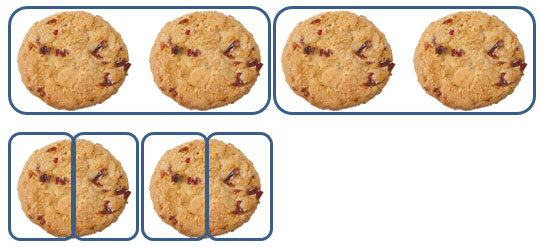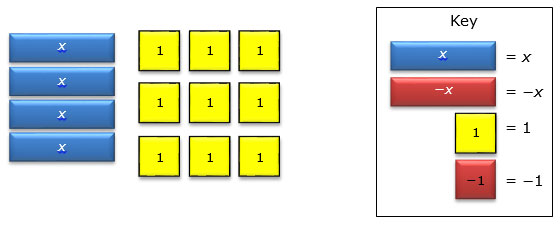You will use a balance scale model to determine whether or not two expressions are equivalent. In this section, you will focus on how the commutative property helps you to determine whether or not two expressions are equivalent.
![]() Use the interactive below to determine whether or not the given expressions are equivalent. Click and drag the blocks representing the first expression onto the left pan of the balance scale. Use the blocks to represent the second expression on the right pan. If the balance scale balances, then the expressions are equivalent. Record your results in a table like the one shown. Click the Next button to see the next pair of expressions.
Use the interactive below to determine whether or not the given expressions are equivalent. Click and drag the blocks representing the first expression onto the left pan of the balance scale. Use the blocks to represent the second expression on the right pan. If the balance scale balances, then the expressions are equivalent. Record your results in a table like the one shown. Click the Next button to see the next pair of expressions.
Copy the following table into a word processing or spreadsheet app or program. Use the results from the interactive to complete the table.
Expression 1 |
Expression 2 |
Equivalent? (Yes/No) |
2x + 4 |
4 + 2x |
|
3(2x) |
2(3x) |
|
3x + 2 |
2x + 3 |
|
x − 3 |
-3 + x |
|
2x − 4 |
4 − 2x |
|
4x + 1 |
1 + 4x |
Interactive popup. Assistance may be required.
Expression 1 |
Expression 2 |
Equivalent? (Yes/No) |
2x + 4 |
4 + 2x |
Yes |
3(2x) |
2(3x) |
Yes |
3x + 2 |
2x + 3 |
No |
x − 3 |
-3 + x |
Yes |
2x − 4 |
4 − 2x |
No |
4x + 1 |
1 + 4x |
Yes |

Use your completed table and the interactive to answer the questions that follow.
Interactive popup. Assistance may be required.
Yes, because the scale is balanced and the scale contains the same number of blocks on both sides.
Interactive popup. Assistance may be required.
Yes, because the scale is balanced and the scale contains the same number of blocks on both sides.
Interactive popup. Assistance may be required.
No, because the scale is unbalanced and the scale does not contain the same number of blocks on both sides.
Interactive popup. Assistance may be required.
No, because the scale is unbalanced and the scale does not contain the same number of blocks on both sides.

Does the order in which numbers are divided affect the answer? Explain.

The commutative property of equality states that when the numbers are rearranged, the result of the operation is the same. For which operations does the commutative property hold true?

Generalize the commutative property using the numbers a and b.
Interactive popup. Assistance may be required.
The commutative property of equality is true only for addition and multiplication.

Luke claims he modeled the expression 4x + 9, but his friend, Yesenia, claims he modeled the expression 9 + 4x. Who is correct? Explain your answer.
Interactive popup. Assistance may be required.
The commutative property is true for addition and multiplication, meaning that you can add numbers in any order or multiply numbers in any order.